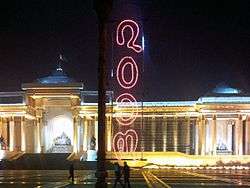Mongolian numerals
Mongolian numerals are numerals developed from Tibetan numerals and used in conjunction with the Mongolian and Clear script.[1][2]:28 They are still used on Mongolian tögrög banknotes.


The main sources of reference for Mongolian numerals are mathematical and philosophical works of Janj khutugtu A.Rolbiidorj (1717-1766) and D.Injinaash (1704-1788). Rolbiidorj exercises with numerals of up to 1066, the last number which he called “setgeshgui” or “unimaginable” referring to the concept of infinity. Injinaash works with numerals of up to 1059. Of these two scholars, the Rolbiidorj’s numerals, their names and sequencing are commonly accepted and used today, for example, in the calculations and documents pertaining to the Mongolian Government budget.
Base numbers
Numbers from 1 to 9 are referred to as "dan", meaning "simple".
| # | Mongolian numerals | Tibetan numerals |
|---|---|---|
| 0 | ᠐ | ༠ |
| 1 | ᠑ | ༡ |
| 2 | ᠒ | ༢ |
| 3 | ᠓ | ༣ |
| 4 | ᠔ | ༤ |
| 5 | ᠕ | ༥ |
| 6 | ᠖ | ༦ |
| 7 | ᠗ | ༧ |
| 8 | ᠘ | ༨ |
| 9 | ᠙ | ༩ |
Extended numbers
| Number | Name in Mongolian | Transliteration |
|---|---|---|
| 10 | Аравт | Aravt (ten) |
| 102 | Зуут | Dzuut (hundred) |
| 103 | Мянгат | Myangat (thousand) |
| 104 | Түмт | Tümt |
| 105 | Бумт | Bumt |
| 106 | Саят | Sayat (million) |
| 107 | Живаа | Jivaa |
| 108 | Дүнчүүр | Dünchüür |
| 109 | Тэрбум | Terbum (billion) |
| 1010 | Их тэрбум | Ikh terbum |
| 1011 | Наяд | Nayad |
| 1012 | Их наяд | Ikh nayad |
| 1013 | Маш дэлгэрмэл | Mash delgermel |
| 1014 | Их маш дэлгэрмэл | Ikh mash delgermel |
| 1015 | Тунамал | Tunamal |
| 1016 | Их тунамал | Ikh tunamal |
| 1017 | Ингүүмэл | Ingüümel |
| 1018 | Их ингүүмэл | Ikh ingüümel |
| 1019 | Хямралгүй | Khyamralgüi |
| 1020 | Их хямралгүй | Ikh Khyamralgüi |
| 1021 | Ялгаруулагч | Yalgaruulagch |
| 1022 | Их ялгаруулагч | Ikh yalgaruulagch |
| 1023 | Өөр дээр | Öör deer |
| 1024 | Их өөр дээр | Ikh öör deer |
| 1025 | Хөөн удирдагч | Khöön udirdagch |
| 1026 | Их хөөн удирдагч | Ikh khöön udirdagch |
| 1027 | Хязгаар үзэгдэл | Khyadzgaar üdzegdel |
| 1028 | Их хязгаар үзэгдэл | Ikh khyadzgaar üdzegel |
| 1029 | Шалтгааны зүйл | Shaltgaany dzüyl |
| 1030 | Их шалтгааны зүйл | Ikh shaltgaany dzüyl |
| 1031 | Үзэсгэлэн гэрэлт | Üdzesgelen gerelt |
| 1032 | Их үзэсгэлэн гэрэлт | Ikh üdzesgelen gerelt |
| 1033 | Эрхт | Erkht |
| 1034 | Их эрхт | Ikh Erkht |
| 1035 | Сайтар хүргэсэн | Saytar khürgesen |
| 1036 | Их сайтар хүргэсэн | Ikh saytar khürgesen |
| 1037 | Олон одох | Olon odokh |
| 1038 | Их олон одох | Ikh olon odokh |
| 1039 | Живэх тоосон билэг | Jivekh tooson bileg |
| 1040 | Их живэх тоосон билэг | Ikh jivekh tooson bileg |
| 1041 | Билэг тэмдэг | Bilet temdeg |
| 1042 | Их билэг тэмдэг | Ikh bilet temdeg |
| 1043 | Хүчин нөхөр | Khüchin nökhör |
| 1044 | Их хүчин нөхөр | Ikh khüchin nökhör |
| 1045 | Тохио мэдэхүй | Tokhio medekhüi |
| 1046 | Их тохио мэдэхүй | Ikh tokhio medekhüi |
| 1047 | Тийн болсон | Tiin bolson |
| 1048 | Их тийн болсон | Ikh tiin bolson |
| 1049 | Хүчин нүд | Khüchin nud |
| 1050 | Их хүчин нүд | Ikh khüchin nüd |
| 1051 | Асрахуй | Asrakhüi |
| 1052 | Их асрахуй | Ikh asrakhüi |
| 1053 | Нигүүлсэнгүй | Nigüülsengüi |
| 1054 | Их нигүүлсэнгүй | Ikh nigüülsengüi |
| 1055 | Баясгалангуй | Bayasgalangüi |
| 1056 | Их баясгалангуй | Ikh bayasgalangüi |
| 1057 | Тоолшгүй | Toolshgüi |
| 1058 | Хэмжээлшгүй | Khemjeelshgüi |
| 1059 | Цаглашгүй | Tsaglashgüi |
| 1060 | Өгүүлшгүй | Ögüülshgüi |
| 1061 | Хэрэглэшгүй | Kheregleshgüi |
| 1062 | Үйлдэж дуусашгүй | Üildej duusashgüi |
| 1063 | Үлэшгүй | Üleshgüi |
| 1064 | Хирлэшгүй | Khirleshgüi |
| 1065 | Үлэж дуусашгүй | Ülej duusashgüi |
| 1066 | Сэтгэшгүй | Setgeshgüi |
References
- Chrisomalis, Stephen (2010). Numerical Notation: A Comparative History. Cambridge University Press. ISBN 9780521878180.
- "The Unicode® Standard Version 10.0 – Core Specification: South and Central Asia-II" (PDF). Unicode.org. Retrieved 3 December 2017.